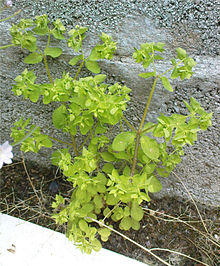bio.wikisort.org - Plant
Euphorbia peplus (petty spurge,[1][2] radium weed,[2] cancer weed,[2] or milkweed),[2] is a species of Euphorbia, native to most of Europe, northern Africa and western Asia, where it typically grows in cultivated arable land, gardens and other disturbed land.[1][3][4]
Outside of its native range it is very widely naturalised and often invasive, including in Australia, New Zealand, North America and other countries in temperate and sub-tropical regions.[1]
Description
It is an annual plant growing to 5–30 cm (2–12 in) tall (most plants growing as weeds of cultivation tend towards the smaller end), with smooth hairless stems. The leaves are oval-acute, 1–3 cm (0.4–1.2 in) long, with a smooth margin. It has green flowers in three-rayed umbels. The glands, typical of the Euphorbiaceae, are kidney-shaped with long thin horns.[4]

Medicinal uses
The plant's sap is toxic to rapidly replicating human tissue, and has long been used as a traditional remedy for common skin lesions.[5] The active ingredient in the sap is a diterpene ester called ingenol mebutate.
A pharmaceutical-grade ingenol mebutate gel has approval from the US Food and Drug Administration for treatment of actinic keratosis.[5][6][7]
In Germany, recent studies have linked Euphorbia peplus with the virtual elimination of squamous cell skin cancer.[8]
References
- "Euphorbia peplus". Germplasm Resources Information Network (GRIN). Agricultural Research Service (ARS), United States Department of Agriculture (USDA). Retrieved 2 January 2018.
- Hazel Dempster; Bronwen Keighery; Greg Keighery; Rod Randall; Bob Dixon; Bill Betts; Margo O'Byrne; Diane Matthews. "Euphorbia terracina Workshop Proceedings 2000" (PDF). Archived from the original (PDF) on 2009-10-25.
- Flora Europaea: Euphorbia peplus
- Blamey, M. & Grey-Wilson, C. (1989). Flora of Britain and Northern Europe. ISBN 0-340-40170-2
- Siller G, Gebauer K, Welburn P, Katsamas J, Ogbourne SM (2009). "PEP005 (ingenol mebutate) gel, a novel agent for the treatment of actinic keratosis: results of a randomized, double-blind, vehicle-controlled, multicentre, phase IIa study". Australasian Journal of Dermatology. 50 (1): 16–22. doi:10.1111/j.1440-0960.2008.00497.x. PMID 19178487. S2CID 19308099.
- Lebwohl, M, et al. "Ingenol Mebutate Gel for Actinic Keratosis." N Engl J Med 366;11, March 15, 2012.
- "FDA Approves Picato® (ingenol mebutate) Gel, the First and Only Topical Actinic Keratosis (AK) Therapy With 2 or 3 Consecutive Days of Once-Daily Dosing". eMedicine. Yahoo! Finance. January 25, 2012. Archived from the original on February 10, 2012.
- Braun, S.A.; Homey, B.; Gerber, P.A. (October 2014). "Erfolgreiche Behandlung eines Morbus Bowen mit Ingenolmebutat". Der Hautarzt (in German). 65 (10): 848–850. doi:10.1007/s00105-014-3509-5. ISSN 0017-8470. PMID 25217087.
External links
- Euphorbia peplus in the CalPhotos photo database, University of California, Berkeley
На других языках
- [en] Euphorbia peplus
[es] Euphorbia peplus
La esula redonda[1] (Euphorbia peplus L.) es una especie fanerógama perteneciente a la familia de las euforbiáceas.[ru] Молочай огородный
Молоча́й огоро́дный, или Молоча́й бутерлаковый (лат. Euphórbia peplus) — однолетнее травянистое растение; вид рода Молочай (Euphorbia) семейства Молочайные (Euphorbiaceae).Другой контент может иметь иную лицензию. Перед использованием материалов сайта WikiSort.org внимательно изучите правила лицензирования конкретных элементов наполнения сайта.
WikiSort.org - проект по пересортировке и дополнению контента Википедии
